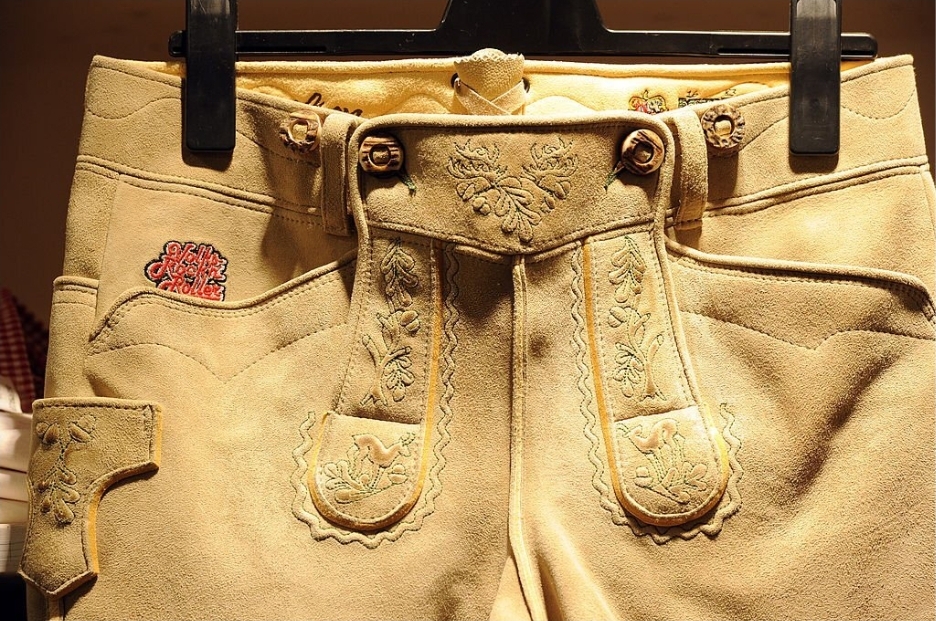Bavaria, the picturesque region in southern Germany, is known for many things—its stunning landscapes, hearty food, and, of course, its vibrant traditions. Among these traditions, German Lederhosen stand out as one of the most iconic symbols of Bavarian heritage. These leather shorts, typically worn by men, have a long history that stretches back centuries, yet they continue to be popular today. But why, in a world that constantly changes, do these leather trousers still hold such a significant place in Bavarian culture? Let’s dive into the origins, meanings, and enduring appeal of German Lederhosen to understand why they remain a beloved part of the region’s identity.
The Historical Roots of German Lederhosen
To understand why German Lederhosen remain so popular, it’s essential to explore their historical origins. The word “Lederhosen” comes from the German words “leder,” meaning leather, and “hosen,” meaning pants. Historically, these leather shorts were worn by peasants, hunters, and workers in rural regions, particularly in Bavaria, Austria, and Switzerland, because of their durability, making them perfect for the hard-working men who spent long hours outdoors. Lederhosen first gained popularity in the 18th century, especially in the Bavarian Alps, where the rugged terrain required clothing that could withstand the demands of physical labor. Leather was the ideal material, tough and resistant to wear, providing protection during outdoor tasks. Over time, Lederhosen came to symbolize not just practical workwear but also the strength and resilience of Bavarian men. As Bavarian society evolved, so did the role of Lederhosen. By the 19th century, they became more than functional garments, transitioning into a symbol of Bavarian pride and tradition, frequently worn during festivals and special occasions. The design also became more intricate, with decorative stitching and embroidery, further solidifying their status as an important cultural garment.
The Symbolic Meaning of Lederhosen in Bavarian Culture
Lederhosen aren’t just shorts—they are a symbol of Bavarian identity, deeply rooted in the region’s history and traditions. Wearing them connects Bavarians to their ancestors, celebrating values such as hard work, resilience, and a close connection to the land. Historically, Lederhosen were tied to Bavarian masculinity, representing the physical strength of men who worked the land, hunted in the forests, and carved out lives in the challenging Alpine environment. In modern times, they’ve evolved into a powerful cultural marker, worn with pride during festivals like Oktoberfest, the world’s largest beer festival, held annually in Munich. Men of all ages don Lederhosen not only as a tribute to their heritage but also to express their enduring connection to Bavarian culture. Tourists also embrace the tradition, often purchasing and wearing Lederhosen during festival season as a way to immerse themselves in local customs. Beyond just fashion or fitting in, wearing Lederhosen at such events symbolizes a deeper celebration of a way of life that has endured for centuries. For Bavarians, slipping into Lederhosen is akin to declaring, “I am proud of where I come from.” This deep-rooted emotional connection keeps German Lederhosen popular year after year. In fact, Lederhosen have become such an iconic part of Bavarian life that many families pass down their leather garments through generations, adding to the sentimental value. The timeless appeal also lies in the craftsmanship, with each pair often personalized, making them more than just clothing—they are symbols of heritage. Additionally, wearing Lederhosen during social gatherings or weddings strengthens communal bonds, as the shared tradition reinforces a collective Bavarian identity. Whether it’s at a village festival or a major cultural event, Lederhosen continue to serve as a visual and emotional link to Bavaria’s enduring customs.
The Design and Craftsmanship of Lederhosen
Another reason why German Lederhosen remain so popular is the unparalleled quality and craftsmanship involved in making them. More than just clothing, Lederhosen are truly works of art, traditionally crafted from high-quality deerskin or goatskin, known for their softness, durability, and ability to withstand years of wear. These materials not only make the shorts comfortable but also long-lasting, with many Lederhosen passed down through generations as cherished family heirlooms. Over the years, the design of Lederhosen has evolved, yet they’ve retained essential elements that link them to their traditional roots, such as intricate embroidery often inspired by nature, including oak leaves, animals, and flowers. The suspenders, another key feature, are also elaborately decorated, contributing to the overall aesthetic and enhancing the visual appeal of the outfit. In the past, nearly every village had a tailor who specialized in Lederhosen-making, passing down techniques from master to apprentice, ensuring a high level of craftsmanship. Even today, despite the availability of mass-produced versions, many Bavarians still seek out handmade, bespoke Lederhosen crafted by local artisans who continue this time-honored tradition. Each piece is often unique, with custom embroidery and personal touches, making them truly one-of-a-kind. The attention to detail ensures that the shorts are not only durable but also a reflection of the wearer’s personality and heritage. This craftsmanship is also evident in the fit; custom-made Lederhosen are tailored to the exact measurements of the individual, providing comfort and durability that off-the-rack versions often lack. Additionally, the process of choosing leather, embroidery, and other design features fosters a deeper connection to the garment, reinforcing its cultural and sentimental significance. By continuing to invest in high-quality, handcrafted Lederhosen, Bavarians ensure that this iconic piece of clothing remains a treasured part of their cultural identity, symbolizing both tradition and artistry for generations to come.
Customization Options for German Lederhosen
One of the most exciting aspects of German Lederhosen is the opportunity for customization, offering wearers the chance to create something truly unique. Whether you’re working with a local tailor or browsing online retailers, you can personalize your Lederhosen with custom embroidery, select different leather types, and even modify the length or cut to suit your specific tastes. This level of personalization ties deeply into the tradition of traditional German clothing, allowing you to celebrate Bavarian heritage in your own way. Embroidery is perhaps the most popular form of customization, with many Bavarians choosing designs that reflect their family heritage, favorite animals, or meaningful personal symbols. From initials and family crests to traditional patterns like oak leaves or deer, the options are nearly limitless. Even the suspenders, often worn with Lederhosen, can be customized with intricate stitching or carvings, adding yet another layer of personal expression. Some artisans even provide unique color options for the stitching and leather, ensuring you can have both a one-of-a-kind piece and a nod to traditional German clothing craftsmanship. These options not only make your Lederhosen stand out but also allow you to wear a garment that reflects your personal style and respect for Bavarian culture, ensuring every piece is as distinctive as the individual wearing it.
Lederhosen as a Fashion Statement
While Lederhosen may have started as practical workwear, they have since evolved into a fashion statement that extends far beyond traditional festivals. In modern-day Bavaria, German Lederhosen aren’t just reserved for special events; many people wear them for everyday activities, especially in rural areas where the connection to tradition remains strong. This everyday use highlights how deeply ingrained Lederhosen are in the cultural fabric of Bavaria. Beyond their local appeal, Lederhosen have also gained international recognition, particularly during Oktoberfest, where visitors from all over the world eagerly don their own pairs to embrace Bavarian culture. Designers have taken notice, experimenting with Lederhosen-inspired styles, incorporating elements of the traditional garment into more contemporary clothing lines. This fusion of old and new ensures that Lederhosen remain relevant in the fast-paced, ever-changing world of fashion. Despite these modern innovations, traditional designs still reign supreme in Bavaria, where most prefer the classic look—short leather trousers paired with a white shirt, traditional shoes, and often a wool jacket or vest for cooler weather. For Bavarians, Lederhosen represent much more than a fashion statement; they are a proud celebration of heritage, a nod to their history, and a way of remaining stylish while staying rooted in cultural respect. Even as they evolve, the craftsmanship and authenticity of the classic designs remain highly valued, ensuring that the timeless appeal of Lederhosen endures. The fact that Lederhosen are worn both by locals and embraced internationally speaks volumes about their ability to transcend generations and trends while remaining a beloved cultural icon.
The Role of Lederhosen in Bavarian Festivals
Festivals play a crucial role in preserving German Lederhosen as a cultural icon, with Bavaria being home to a rich tradition of such events. Oktoberfest, the most famous of these festivals, held annually in Munich, attracts millions of visitors from around the world, all eager to experience Bavarian culture, drink beer, and, of course, wear traditional clothing like Lederhosen. During Oktoberfest, Lederhosen are everywhere—worn by both locals and tourists, creating a vibrant scene of leather-clad festival-goers. Typically paired with a white or checkered shirt, woolen socks, and sturdy shoes, Lederhosen are part of the quintessential Bavarian look, while women often wear Dirndls, complementing the men’s attire and further emphasizing the importance of traditional German clothing at these events. Beyond Oktoberfest, Lederhosen are also worn at numerous other festivals throughout the year, such as religious celebrations, harvest festivals, and even weddings, demonstrating their versatility and deep-rooted cultural significance. These events offer Bavarians a chance to come together as a community, celebrating shared history and reinforcing the tradition of wearing Lederhosen, which has been passed down through generations. Lederhosen at these gatherings serve as more than just clothing—they embody a sense of continuity, connecting the past with the present. Their presence at these celebrations reinforces Bavarian identity, while tourists, eager to immerse themselves in the local culture, often adopt the attire, further contributing to its enduring popularity. The festivals not only preserve the tradition but also elevate Lederhosen from practical wear to an enduring symbol of Bavarian unity and pride. The sight of families and friends dressed in Lederhosen at these events fosters a sense of belonging and pride in Bavarian culture, ensuring that the tradition will thrive for future generations.
The Popularity of Lederhosen Among the Younger Generation
One might think that Lederhosen would be viewed as old-fashioned by younger generations, but this couldn’t be further from the truth. Bavarian youth are just as enthusiastic about wearing German Lederhosen as their parents and grandparents, seeing it as a way to express both identity and individuality within a collective cultural framework. In recent years, there has been a noticeable resurgence in traditional Bavarian fashion among the younger generation, with many proudly wearing Lederhosen not just at festivals but also at parties and social gatherings. This revival has allowed Lederhosen to remain relevant, with younger people embracing the opportunity to add personal touches, whether through unique embroidery, colorful accessories, or even modern fits. Customization has become increasingly popular, reflecting the desire of young Bavarians to make this traditional German clothing their own while staying true to its roots. Social media platforms like Instagram and TikTok have also played a significant role in maintaining Lederhosen’s popularity, with photos and videos of young people showcasing their traditional Bavarian attire reaching a global audience. Influencers and content creators often share their Lederhosen looks, which sparks curiosity and enthusiasm from viewers around the world, further enhancing its appeal. The adaptability of Lederhosen, combined with this newfound digital exposure, ensures that these iconic garments continue to thrive. What’s more, the younger generation is not only preserving but reinventing traditional German clothing, ensuring that it stays a vibrant and integral part of Bavarian culture for years to come. Their creative interpretations help bridge the gap between past and present, allowing Lederhosen to evolve without losing its deep historical significance.
The Influence of Tourism on Lederhosen’s Popularity
Tourism has played a significant role in the enduring popularity of German Lederhosen, with Bavaria being one of the most visited regions in Germany. Millions of tourists flock to cities like Munich, Nuremberg, and the scenic villages of the Alps each year, and for many, buying a pair of Lederhosen is a must-do experience. Wearing Lederhosen during Oktoberfest or other cultural events makes the trip even more memorable, allowing visitors to immerse themselves in Bavarian tradition. Local shops and artisans have capitalized on this demand by offering a wide range of styles, from traditional designs to more modern interpretations, making Lederhosen accessible to all. This accessibility has contributed to Lederhosen’s global recognition as a symbol of Bavaria. Tourists who purchase Lederhosen often wear them at festivals in their own countries, further spreading the appeal and cultural significance of these iconic shorts. The tourism industry’s embrace of Lederhosen has also sparked a renewed interest in the craftsmanship and history behind the garment, with many visitors seeking to learn more about Bavarian culture. In addition to keeping the tradition alive, tourism helps educate people worldwide about the importance of traditional German clothing in Bavarian life. Many visitors return home with not only their own pair of Lederhosen but also a deeper appreciation for Bavarian craftsmanship and culture. As tourism continues to grow, the exposure and allure of Lederhosen increase, turning this traditional attire into a symbol of cultural connection and pride. This expanding global interest ensures that the tradition of wearing Lederhosen will continue to flourish for years to come.
Where to Buy Authentic German Lederhosen
If you’re looking to purchase German Lederhosen, there are many options available, both locally in Bavaria and online. In cities like Munich, you’ll find specialty stores offering a wide variety of traditional and modern styles. One of the best times to shop for Lederhosen is during Oktoberfest, where vendors sell high-quality, handcrafted pieces. However, for those who prefer the convenience of shopping online, there are excellent retailers that provide a range of authentic Bavarian attire. Among them, eDirndl stands out as a top choice for buying authentic Lederhosen. Known for offering a wide selection of traditional German clothing, eDirndl provides high-quality, handcrafted Lederhosen made from genuine materials like deerskin and goatskin. They also ship worldwide, so whether you’re preparing for Oktoberfest or simply looking to embrace Bavarian tradition, eDirndl allows you to easily find the perfect pair from the comfort of your home. When buying online, it’s crucial to check the leather quality, as authentic Lederhosen should be durable and comfortable, and eDirndl excels in providing this. Make sure to consult their detailed sizing guides to ensure the best fit, as traditional Lederhosen are designed to be snug and tailored for comfort.
The Future of German Lederhosen in Bavarian Culture
The future of German Lederhosen looks bright, as current trends suggest that these iconic garments are here to stay. While the world continues to change, the values that Lederhosen represent—tradition, pride, craftsmanship, and community—are just as relevant today as they were centuries ago. Lederhosen have managed to evolve with the times, blending modern elements with their traditional roots, ensuring their continued appeal. As younger generations continue to embrace Bavarian traditions, and as festivals like Oktoberfest gain even more global popularity, Lederhosen will remain a central part of Bavarian culture. Whether worn as a bold fashion statement, a proud symbol of heritage, or simply as a way to connect with the community, Lederhosen are more than just shorts—they embody the living spirit of Bavarian life. The growing customization options, including personal embroidery and unique leather types, only add to their appeal, allowing individuals to create pieces that are both modern and timeless. As tourists and locals alike continue to celebrate Bavarian traditions, Lederhosen’s role in preserving this culture will only deepen. The international exposure through social media and global events ensures that the allure of Lederhosen will continue to spread, keeping this cherished symbol of Bavaria thriving for generations to come.
Conclusion
In conclusion, the enduring appeal of German Lederhosen lies in their ability to connect the past with the present, offering a tangible link to a rich cultural history while remaining relevant in modern times. Through festivals, craftsmanship, fashion, and tourism, Lederhosen continues to play a vital role in Bavarian culture, ensuring that this iconic garment remains a beloved tradition for generations to come. Their adaptability allows them to evolve with changing trends, yet they still preserve the essence of Bavarian heritage. Whether worn by locals at Oktoberfest or embraced by tourists eager to participate in the culture, Lederhosen have become more than just a symbol of Bavaria—they are a global representation of the region’s identity. As younger generations continue to personalize and celebrate this traditional German clothing, the future of Lederhosen remains secure, firmly woven into the cultural fabric of Bavaria. It’s this timeless blend of history, pride, and style that ensures Lederhosen will always have a place in Bavarian life.
Keep an eye for more latest news & updates on Gossips!




